Orthopedic Clinic Business Plan Template & PDF Example
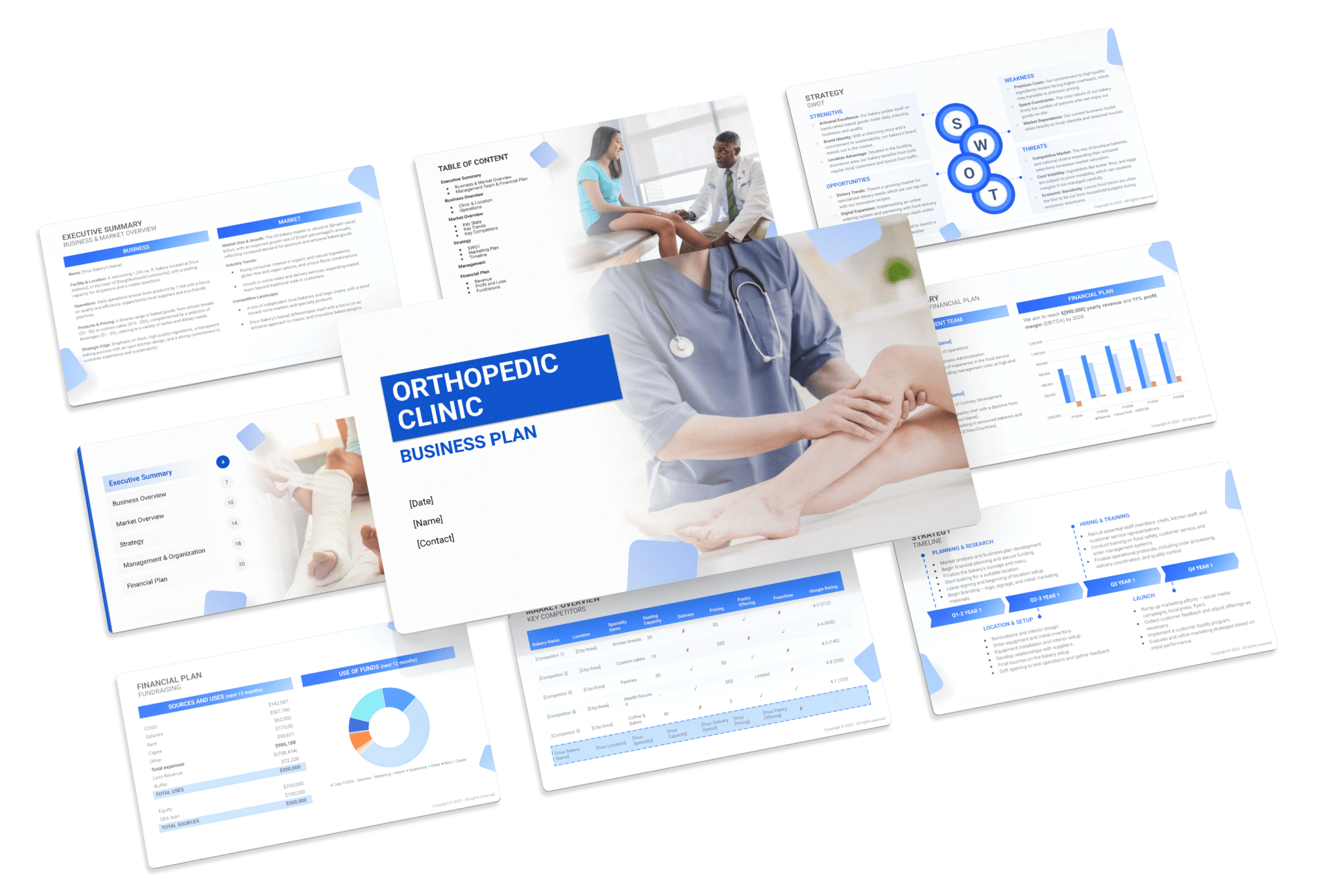
Creating a comprehensive business plan is crucial for launching and running a successful orthopedic clinic. This plan serves as your roadmap, detailing your vision, operational strategies, and financial plan. It helps establish your orthopedic clinic’s identity, navigate the competitive market, and secure funding for growth.
This article not only breaks down the critical components of an orthopedic clinic business plan, but also provides an example of a business plan to help you craft your own.
Whether you’re an experienced entrepreneur or new to the healthcare industry, this guide, complete with a business plan example, lays the groundwork for turning your orthopedic clinic concept into reality. Let’s dive in!
The Plan
Our orthopedic clinic business plan is structured to encompass all vital elements necessary for a robust strategy. It outlines the clinic’s operations, marketing approach, market environment, competitors, management team, and financial predictions.
- Executive Summary: Offers an overview of the Orthopedic Clinic’s business concept, emphasizing its specialized orthopedic services, market analysis highlighting the growing demand for orthopedic care, a highly qualified management team, and a financial strategy aimed at achieving sustainability and growth.
- Business Overview: Provides detailed information on the orthopedic services offered and the operational model of the clinic:
- Clinic & Location: Describes the clinic’s design, state-of-the-art orthopedic equipment, patient amenities, and the strategic significance of its location for accessibility and patient convenience.
- Operations: Lists the comprehensive range of orthopedic treatments available, including fracture care, joint replacement, etc. alongside a transparent pricing model.
- Market Overview: Examines the orthopedic care industry landscape, identifying key competitors and differentiating factors of the Orthopedic Clinic:
- Key Stats: Discusses the industry’s size and growth trends, emphasizing the increasing interest in minimally invasive surgical techniques and treatments for an aging population.
- Key Trends: Highlights significant trends such as the integration of advanced technology in treatment and diagnostics, the focus on value-based care, and the shift towards ambulatory surgery centers.
- Key Competitors: Analyzes the main competitors in the area, noting how the Orthopedic Clinic distinguishes itself through its wide range of specialized services, advanced treatment techniques, and patient-centered care approach.
- Strategy: Outlines the Orthopedic Clinic’s strategic plan for growth and patient attraction:
- SWOT: A detailed Strengths, Weaknesses, Opportunities, and Threats analysis, tailored to the Orthopedic Clinic’s context, to inform strategic planning.
- Marketing Plan: A comprehensive strategy for promoting the clinic’s services, including digital marketing, partnerships with healthcare providers, patient education seminars, and community health initiatives.
- Timeline: Sets key milestones and objectives from the clinic’s conceptualization through to its first year of operation, including critical phases like staff recruitment, service launch, and the initiation of marketing activities.
- Management: Provides information on the Orthopedic Clinic’s management team, detailing the roles, qualifications, and expertise of key personnel, emphasizing their capability to lead the clinic towards achieving its strategic goals.
- Financial Plan: Projects the Orthopedic Clinic’s 5-year financial performance, including detailed forecasts of revenue from various treatments, projected expenses, and profitability analysis to demonstrate the clinic’s potential for financial success and operational sustainability.

Executive Summary
The Executive Summary introduces your orthopedic clinic’s business plan, offering a concise overview of your clinic and its services. It should detail your market positioning, the range of orthopedic and rehabilitative services you offer, its location, size, and an outline of day-to-day operations.
This section should also explore how your orthopedic clinic will integrate into the local healthcare market, including the number of direct competitors within the area, identifying who they are, along with your clinic’s unique selling points that differentiate it from these competitors.
Furthermore, you should include information about the management and co-founding team, detailing their roles and contributions to the clinic’s success. Additionally, a summary of your financial projections, including revenue and profits over the next five years, should be presented here to provide a clear picture of your clinic’s financial plan.
Orthopedic Clinic Business Plan Executive Summary Example
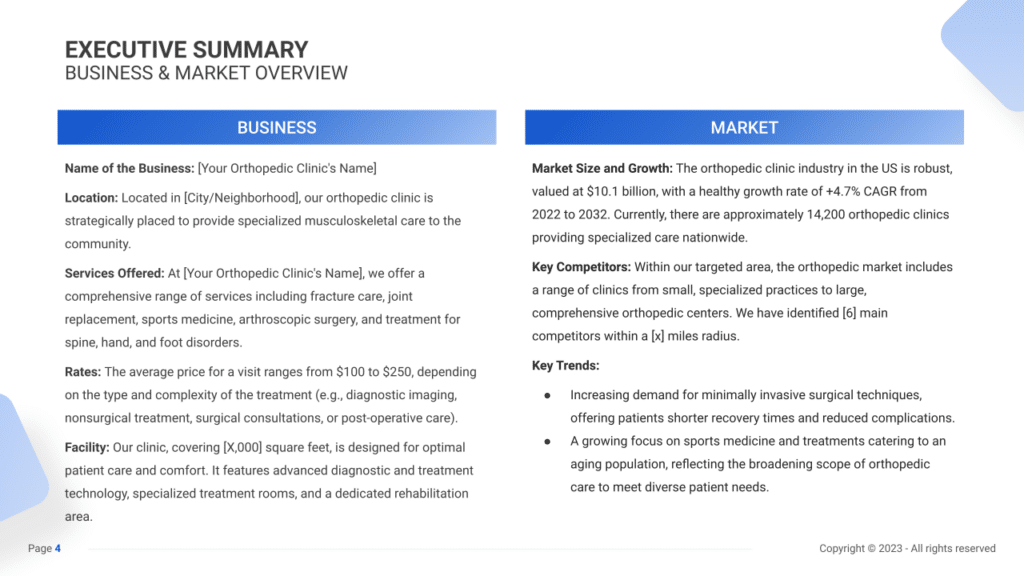
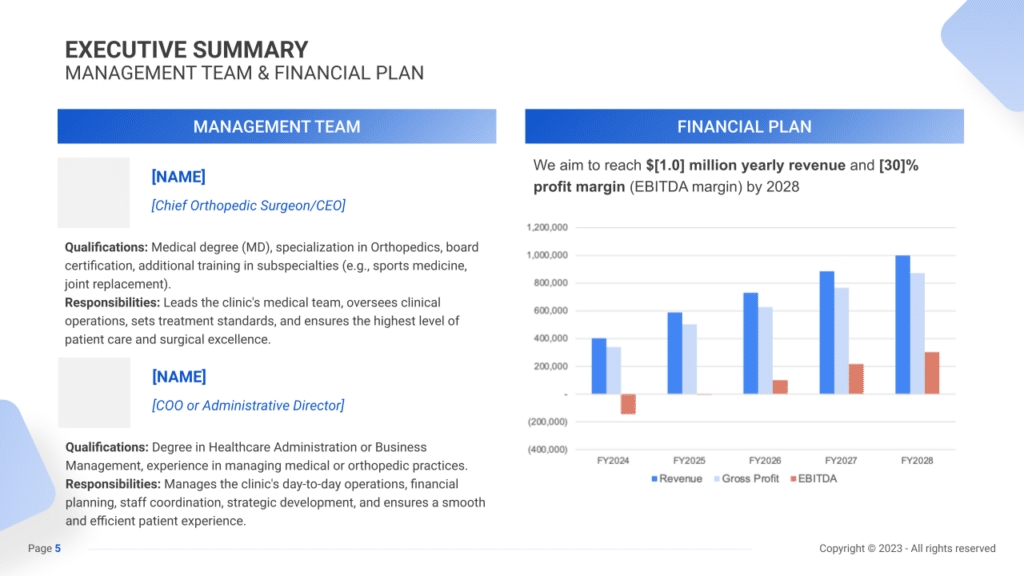
Business Overview
Presenting a concise yet vivid picture of your orthopedic clinic sets the foundation for understanding its unique positioning in the market. Begin by detailing the clinic’s name, location, and an overview of the services offered.
Highlighting your clinic’s distinguishing features is vital. Whether it’s advanced diagnostic technology, specialized treatment rooms, or a patient-centric approach, these aspects define your clinic’s value proposition.
Example:
“[Your Orthopedic Clinic’s Name],” strategically located in [City/Neighborhood], specializes in providing comprehensive musculoskeletal care. Our services encompass a wide array of treatments, including fracture care, joint replacement, sports medicine, arthroscopic surgery, and specialized care for spine, hand, and foot disorders.
Market Overview
Understanding the orthopedic industry landscape and your clinic’s positioning within it is crucial. Provide insights into the market size, growth projections, and competitive analysis. Emphasize key industry trends shaping the future of orthopedic care.
Example:
The orthopedic clinic industry in the US thrives at $10.1 billion, displaying a robust +4.7% CAGR from 2022 to 2032. Within our target area, competition spans from specialized practices to comprehensive orthopedic centers. Identifying and addressing market trends such as minimally invasive surgical techniques and the increasing focus on sports medicine remain pivotal to our strategy.
Management Team
The expertise and capabilities of your clinic’s management team are integral. Highlight the qualifications, experiences, and responsibilities of key team members, showcasing their prowess and contributions.
Example:
Our management team, led by individuals with degrees in Healthcare Administration or Business Management, ensures seamless day-to-day operations, financial planning, strategic development, and a patient-centric experience. Their collective experience in managing medical or orthopedic practices positions our clinic for success and growth.
Financial Plan
A robust financial plan delineates the clinic’s growth trajectory. Summarize financial goals, revenue projections, and strategies for achieving them, providing a clear roadmap for financial success.
Example:
[Your Orthopedic Clinic’s Name] aims to achieve a yearly revenue of $1.0 million by 2028, reflecting an upward trajectory and steady expansion of our services and patient base. Concurrently, we aim for a 30% profit margin (EBITDA margin) by the same year, underscoring our commitment to operational efficiency and prudent financial management. This plan entails strategic resource allocation, incorporating prudent investments in state-of-the-art technology, specialized staff training, and targeted marketing endeavors.
Business Overview
For an Orthopedic Clinic, the Business Overview section can be effectively divided into 2 main slides:
Clinic & Location
Briefly describe the clinic’s physical environment, focusing on its design, accessibility, and the professional atmosphere that reassures and welcomes patients. Mention the clinic’s location, highlighting its convenience for patients, such as proximity to major transportation routes or integration within a medical complex. Explain why this location is beneficial for reaching your target patient demographic and ensuring ease of access for those with mobility issues.
Operations & Services
Detail the range of orthopedic services and treatments offered, from routine consultations and diagnostics to advanced surgical procedures and post-surgery rehabilitation. Outline your service delivery model, ensuring it reflects the high standard of care and aligns with the expectations of your target market. Highlight any specialized programs, such as sports injury rehabilitation, pediatric orthopedics, or geriatric orthopedic care, that provide added value to your patients, fostering patient engagement and loyalty.

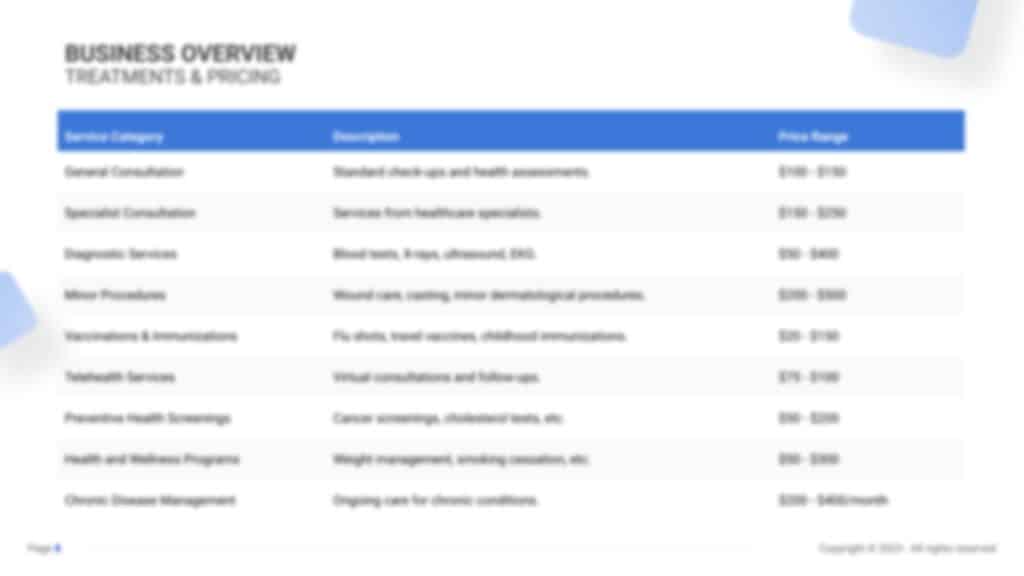
Market Overview

Industry size & growth
In the Market Overview of your orthopedic clinic business plan, begin by examining the size of the orthopedic care industry and its growth potential. This analysis is essential for understanding the market’s scope and pinpointing areas for expansion.
Key market trends
Proceed to discuss recent market trends, such as the growing patient preference for minimally invasive surgical techniques, the increasing use of telemedicine for consultations and follow-ups, and the emphasis on integrated care models that combine surgical treatment with physiotherapy and rehabilitation.
For instance, highlight the demand for services that cater to specific orthopedic needs, such as sports injuries, joint replacements, or pediatric orthopedics, alongside the rising interest in clinics that offer comprehensive care from diagnosis to full recovery.
Competitive Landscape
A competitive analysis is not just a tool for gauging the position of your orthopedic clinic in the market and its key competitors; it’s also a fundamental component of your business plan. This analysis helps identify your orthopedic clinic’s unique selling points, essential for differentiating your business in a competitive market.
In addition, competitive analysis is integral in laying a solid foundation for your business plan. By examining various operational aspects of your competitors, you gain valuable information that ensures your business plan is robust, informed, and tailored to succeed in the current market environment.
Identifying Competitors in the Orthopedic Healthcare Sector
Begin by identifying the immediate and secondary competitors in the orthopedic healthcare sector. Immediate competitors might include other orthopedic clinics, hospitals with specialized orthopedic departments, and private practices within your geographical area. Additionally, consider secondary competitors such as physical therapy centers or chiropractic clinics that offer overlapping services.
Utilize various resources to map out the competitive landscape. Online directories, healthcare provider databases, and professional networks can help create a comprehensive list of competing establishments. Patient reviews on platforms like Healthgrades or Zocdoc could offer valuable insights into the strengths and weaknesses of these competitors, highlighting areas of patient satisfaction or dissatisfaction.
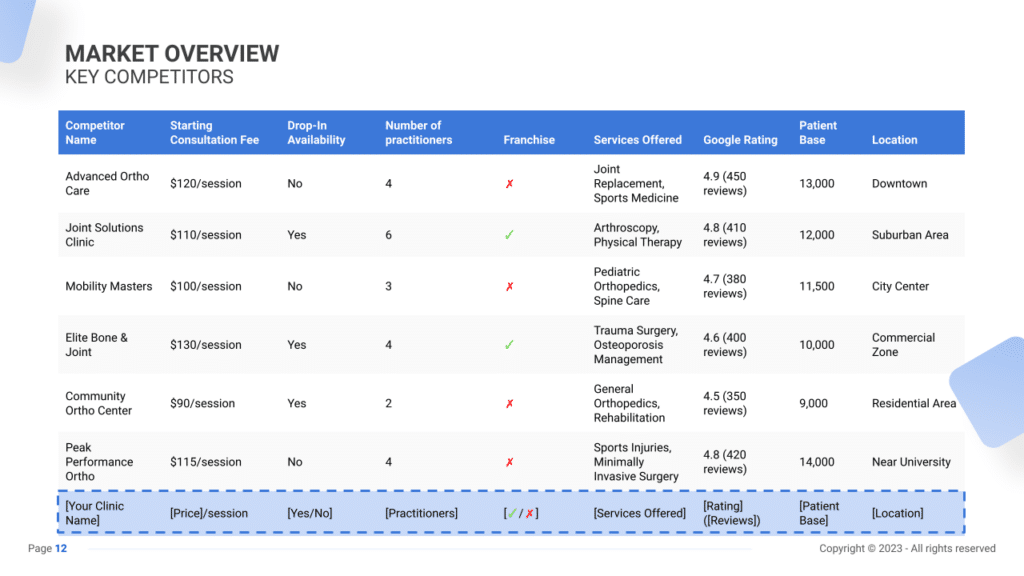
Orthopedic Clinic Competitors’ Strategies and Offerings
Analyze the strategies and offerings of your identified competitors across several key areas:
- Medical Specializations: Evaluate the range of orthopedic specialties your competitors focus on. For instance, a clinic might specialize in sports medicine, while another emphasizes joint replacement surgeries or spinal care. Understanding these focal points can guide your clinic in carving out its niche or emphasizing unique specialties.
- Treatment Techniques and Technology: Assess the treatment techniques and technological advancements utilized by competitors. Some clinics might be known for adopting innovative procedures, while others may pride themselves on utilizing state-of-the-art equipment for diagnosis and surgeries.
- Service Pricing: Compare the pricing structure of your services with that of competitors. Consider whether your clinic’s pricing aligns with premium services offered by high-end orthopedic centers or if it caters to a more cost-conscious market segment.
- Marketing and Patient Engagement: Analyze the marketing tactics employed by competing clinics. Do they heavily invest in digital marketing, patient education, or community outreach programs? Understanding these approaches can help tailor your clinic’s marketing strategy for maximum impact.
- Patient Experience and Care Delivery: Assess the overall patient experience at competitor facilities. Factors such as waiting times, appointment scheduling, post-operative care, and patient-doctor interactions play a crucial role in patient satisfaction and loyalty.
- Operational Efficiency and Technology Integration: Observe how competitors leverage technology for administrative tasks, appointment scheduling, electronic health records, and telemedicine services. Clinics with streamlined operational processes might have a competitive edge in patient convenience and satisfaction.
What’s Your Orthopedic Clinic’s Value Proposition?
Define your orthopedic clinic’s unique value proposition that sets it apart from competitors. It could be a particular specialization, a renowned expert on your team, or innovative treatment methodologies not commonly available in your area.
Consider market trends and patient demands. For example, an increasing focus on minimally invasive surgeries or holistic rehabilitation methods may present opportunities for your clinic to cater to specific patient needs that competitors overlook.
Tailor your clinic’s positioning based on location and demographics. A clinic situated in an urban area might emphasize cutting-edge technology and quick service, while one in a suburban locale might prioritize a more personalized patient experience and family-oriented care.
Strategy

SWOT
First, conduct a SWOT analysis for the orthopedic clinic, highlighting Strengths (such as experienced orthopedic specialists and state-of-the-art medical equipment), Weaknesses (including reliance on healthcare insurance reimbursements or intense competition in the area), Opportunities (for example, an aging population with increasing orthopedic needs or advancements in orthopedic treatments), and Threats (such as changes in healthcare regulations that may affect operational costs or reimbursement rates).
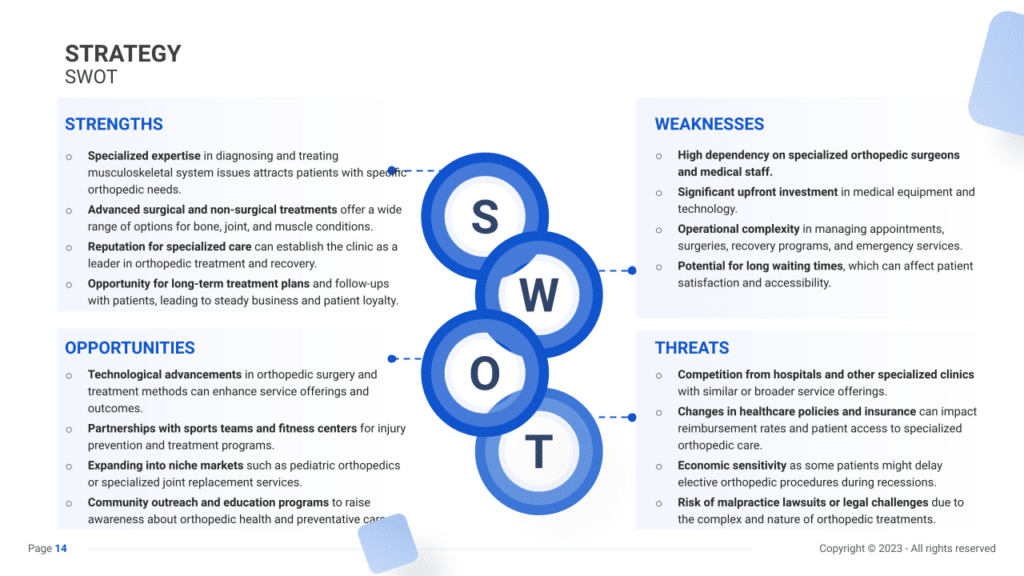
Marketing Plan
Next, develop a marketing strategy that outlines how to attract and retain patients through targeted advertising in healthcare publications, promotional health check-up camps, an informative and engaging online presence, and community involvement through health awareness programs.
Marketing Channels
Digital Marketing
In today’s digital era, leveraging online platforms is indispensable for reaching and engaging with your audience effectively.
- Website and SEO: Develop a user-friendly website featuring comprehensive information about your services, patient testimonials, educational content on orthopedic health, and an intuitive appointment scheduling system. Optimize the website for search engines to rank higher in local searches.
- Content Marketing: Produce valuable content through blogs, videos, infographics, and podcasts offering insights into orthopedic procedures, recovery guidance, patient success stories, and tips for maintaining orthopedic health.
- Social Media Engagement: Utilize various social media platforms such as LinkedIn, Twitter, Instagram, Facebook, YouTube, or TikTok to disseminate informative content, share industry news, and patient testimonials, and engage with the audience through interactive posts, live sessions, and Q&A sessions.
Local Advertising
Strengthening your local presence is essential for connecting with the community and potential patients.
- Online Directories: List your clinic on local healthcare directories, Google My Business, Yelp, Healthgrades, and other online platforms to improve visibility among local audiences actively seeking orthopedic services.
- Partnerships: Collaborate with local physical therapy centers, fitness studios, athletic clubs, or sports teams for collaborative events, sponsorships, or referral programs to expand your reach and tap into diverse patient groups.
Promotional Activities
Educational Events
Hosting educational events aids in establishing credibility, nurturing patient trust, and educating the community about orthopedic health.
- Workshops and Seminars: Organize informative sessions on orthopedic health, injury prevention, rehabilitation, or post-operative care. Invite specialists to speak on specific topics to engage with the audience and establish your clinic as a reliable source of information.
- Physician Referral Network: Forge partnerships with primary care physicians, physiotherapists, chiropractors, and other healthcare providers. Establish a reliable referral network where professionals can confidently refer patients to your clinic for specialized orthopedic care.
- Patient Referral Incentives: Implement a patient referral program offering incentives to existing patients, such as discounted services, gift vouchers, or exclusive perks for referring friends, family, or colleagues to the clinic.
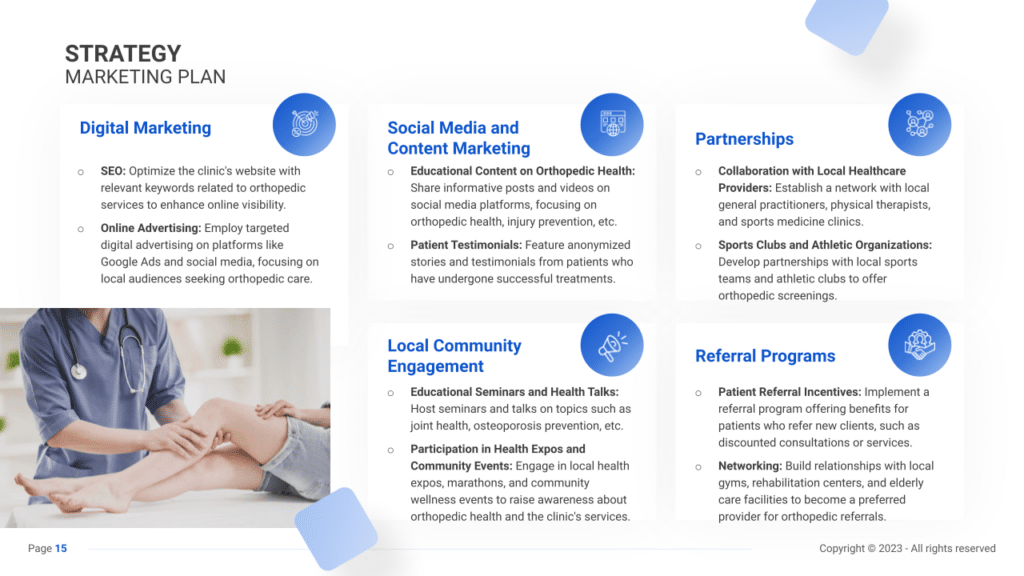
Sales Channels
Patient Experience Enhancement
Focusing on delivering an exceptional patient experience is key to ensuring patient satisfaction and loyalty.
- Personalized Care: Emphasize personalized treatment plans tailored to individual patient needs and preferences. Provide comprehensive consultations, clear communication, and empathetic care to build lasting relationships.
- Follow-Up Care: Implement a robust follow-up system to monitor patient progress post-treatment, ensure their well-being, and offer support or further guidance as necessary. This demonstrates the clinic’s commitment to comprehensive patient care beyond the initial treatment.
Telemedicine and Online Services
Embracing telehealth solutions facilitates accessibility and convenience for patients seeking remote healthcare services.
- Teleconsultations: Offer secure and convenient virtual consultations for initial assessments, follow-ups, or post-operative care. This caters to patients who prefer remote healthcare options or have mobility constraints.
- Online Patient Portal: Develop a user-friendly online platform allowing patients to access medical records, schedule appointments, receive personalized health advice, and communicate securely with healthcare providers, enhancing patient engagement and convenience.
Membership and Loyalty Programs
Establishing membership and loyalty programs can foster patient loyalty and encourage repeat visits.
- Patient Membership Plans: Design subscription-based membership plans offering regular orthopedic check-ups, discounts on services, exclusive access to educational materials, priority scheduling, or additional perks to incentivize patient loyalty.
- Loyalty Rewards: Create a loyalty program where patients earn points or rewards for consistent visits, adherence to treatment plans, or referrals, redeemable for discounts on services, free consultations, or other valuable benefits, fostering a sense of appreciation and belonging among patients.
Strategy Timeline
Finally, create a detailed timeline that outlines critical milestones for the orthopedic clinic’s inauguration, marketing initiatives, patient base growth, and expansion goals, ensuring the business advances with clear direction and purpose.

Management
The Management section focuses on the orthopedic clinic’s management and its direct roles in daily operations and strategic direction. This part is crucial for understanding who is responsible for making key decisions and driving the orthopedic clinic toward its financial and operational goals.
For your orthopedic clinic business plan, list the core team members, their specific responsibilities, and how their expertise supports the orthopedic clinic’s mission.


Financial Plan
The Financial Plan section is a comprehensive analysis of the orthopedic clinic’s financial strategy, including projections for revenue, expenses, and profitability. It lays out the orthopedic clinic’s approach to securing funding, managing cash flow, and achieving breakeven.
This section typically includes detailed forecasts for the first 5 years of operation, highlighting expected revenue, operating costs and capital expenditures.
For your orthopedic clinic business plan, provide a snapshot of your financial statement (profit and loss, balance sheet, cash flow statement), as well as your key assumptions (e.g. pricing strategies for memberships and services, etc.).
Make sure to cover here
_ Profit and Loss
_ Cash Flow Statement
_ Balance Sheet
_ Use of Funds









